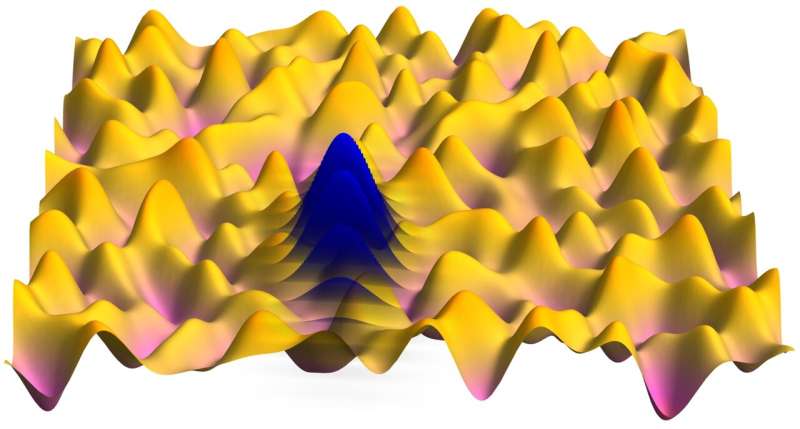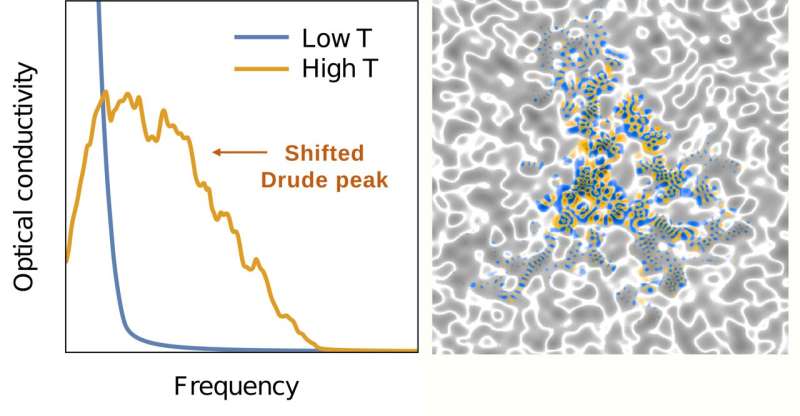June 4, 2024 feature
This article has been reviewed according to Science X's editorial process and policies. Editors have highlighted the following attributes while ensuring the content's credibility:
fact-checked
peer-reviewed publication
trusted source
proofread
Study uncovers a quantum acoustical Drude peak shift in strange metals

Researchers at Harvard University, Sabanci University, and Peking University recently gathered findings that could shed light on the origin of the high-temperature absorption peaks observed in strange metals, a class of materials exhibiting unusual electronic properties that do not conform to the conventional theory of metals.
Their paper, published in Physical Review Letters, specifically shows that dynamical lattice disorder in strange metals steers them towards non-Drude physical behavior associated with these high-temperature absorption peaks.
"A key concept behind our latest work is quantum acoustics—a recently developed framework parallel to quantum optics—which establishes a time-dependent, nonperturbative treatment of the electron–phonon interaction in real space, emphasizing the wave nature of lattice vibrations and consequently enabling us to explore uncharted territories of electron-lattice dynamics," Joonas Keski-Rahkonen, co-author of the paper, told Phys.org.
"Our general objective was to demonstrate the power of this new approach, which has always been available in principle, but never before fully employed."
The key objective of the recent work by Keski-Rahkonen and his colleagues was to investigate so-called Drude peak displacement. This is a shift of the optical conductivity maximum to higher frequencies with increasing temperatures, which has been reported in various materials deemed to be strange metals.
The researchers also set out to demonstrate how Drude peak displacement is formed in these materials. Specifically, they hypothesized that it results from electrons interacting with fluctuating lattice degrees of freedom.
"A starting point for us is the standard Fröhlich model that is widely used to describe the electron-lattice dynamics," Keski-Rahkonen explained. "However, we express it within the coherent state picture that is the dual partner of the traditional number state description but inspires very different approximations. In simple terms, we treat lattice vibrations as waves rather than individual phonons."

The quantum-acoustical framework employed by the researchers led them to describe the interaction between electrons and a material's lattice as a morphing and propagating landscape of "hills" and "valleys," called "deformation potential." They proposed that electrons roam and scatter within this swiftly changing landscape.
Subsequently, Keski-Rahkonen and his colleagues numerically computed the corresponding optical conductivity for three prototypical strange metals at a wide range of temperatures. They did this using the common Kubo formula, a theoretical construct used to calculate linear response functions in quantum and classical physical systems.
"The current work addresses the specific question of whether experimentally observed displaced Drude peaks (DDPs) could arise at all, even as a matter of principle, from lattice vibrations, which is commonly discarded as a possible mechanism for strange metal enigmas," Keski-Rahkonen said.
"This work shows that the answer is a definite yes, as without any fine-tuning, boost-trapping or fitting parameters, we have introduced the phenomenon of quantum-acoustical Drude peak displacement, which involves the temperature-dependent shift and broadening of the optical conductivity peak to finite frequencies, quantitively agreeing with the experimental evidence."
The recent study by Keski-Rahkonen and his collaborators could be an important step towards the better understanding of strange metals and their unique physics. In addition, their findings propose that a transient localization process could underlie DDP, specifically a subtle rise and fall of the Anderson localization of electrons caused by a dynamical disorder field caused by thermal lattice vibrations.
"We see this as one of the first milestones on the path of quantum acoustics," Keski-Rahkonen added. "A natural, follow-up question is what other strange metal mysteries we can unravel with this new shiny tool we have.
"Outside the milieu of strange metals, we have already shown how the transport theory of 'ordinary metals' arises within the framework of quantum acoustics.
"Another interesting avenue for future research would be to study quantum acoustics in the context of semiconductors, for instance, to investigate the birth and evolution of polarons with our tools."
More information: Joonas Keski-Rahkonen et al, Quantum-Acoustical Drude Peak Shift, Physical Review Letters (2024). DOI: 10.1103/PhysRevLett.132.186303. On arXiv: DOI: 10.48550/arxiv.2310.19143
Journal information: Physical Review Letters , arXiv
© 2024 Science X Network




















